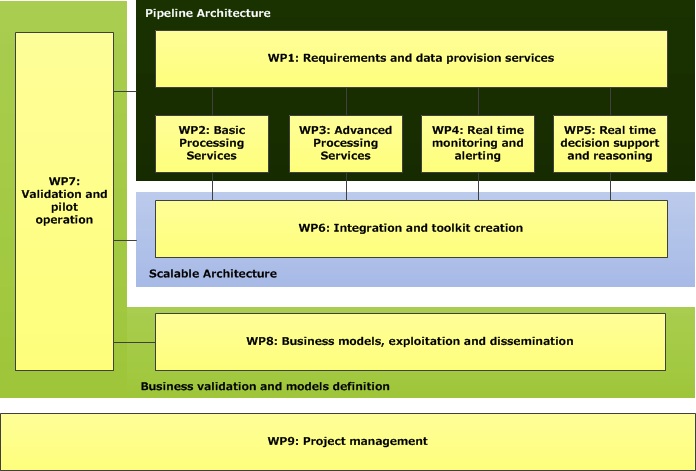NRG4CAST will utilize integration technologies such as semantic web aspects, open service oriented architectures, technology, data distribution services for publisher / subscriber messaging methods, etc., in order to build the proposed integrated platform and extend further the before mentioned state of the art in service composition and integration techniques. Semantic Web offers a great opportunity to support data semantization based on a domain-specific ontology database. Process coordination based on web services gives a unified way to cooperate various subsystems among different organizations. Publisher / Subscriber architectures (pub/sub) through Data Distribution Service (DDS) middleware enables distributed communication that is loosely coupled, reliable, and asynchronous in complex network environment.
Workplan
The overall strategy of the NRG4Cast follows four general principles to tackle the challenge of the project:
- A pipeline architecture, where each of the steps of the pipelines enriches the processed content. Each component is covered by one Work Package.
- Scalable technologies to deal with the highly dynamic and rich data sources. At the same time, due to the richness of the data sources we can reuse the redundancy of the information in order to improve the quality of the results.
- Redundant technologies in the project ensure that hard cases can be tackled, and increase the coverage of the pipeline used. The pipeline is resilient, so that even if a component fails to analyse an item, the other components can provide backup.
- Business validation and models definition. NRG4Cast solution will be tested in real-life operation using applications coming from environmental monitoring in municipalities, traffic information data, electrical vehicles charging systems and energy-efficiency in buildings.
Technology status
A comprehensive review of energy forecasting technology gather important information about the key concepts and devices that are currently installed or are at different stages of development and will potentially identify emerging technological improvements to enhance the durability and cost-effectiveness of energy forecasting technology. [more]
Technology gaps & barriers
Information from technology priorities in other developed tools for energy forecasting will be covered and comparison of strategic research agendas against the information collected in consultation process, in order to identify the gaps for commercial development energy forecasting technologies.

